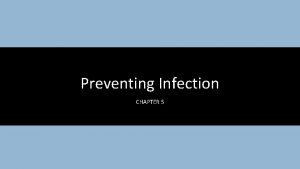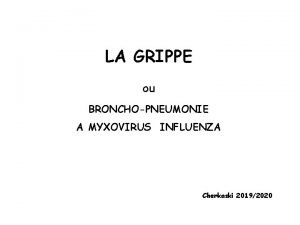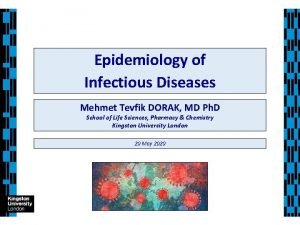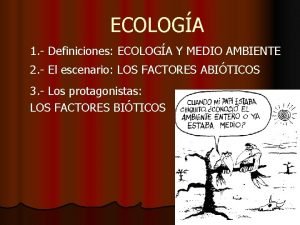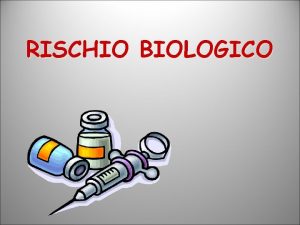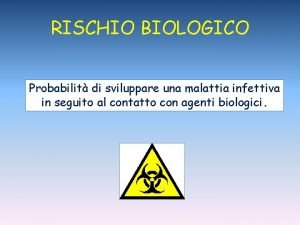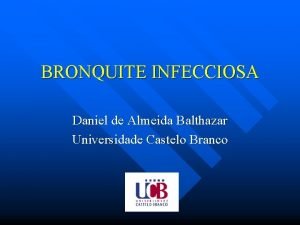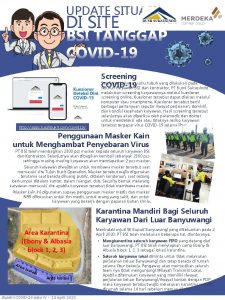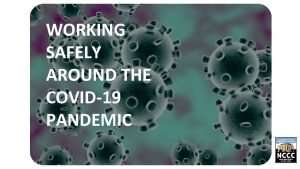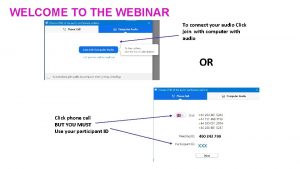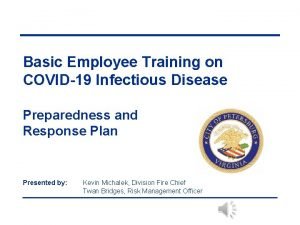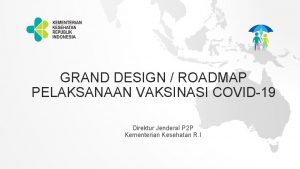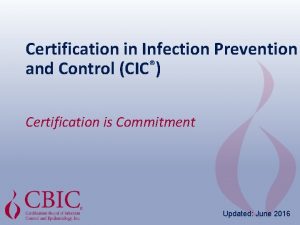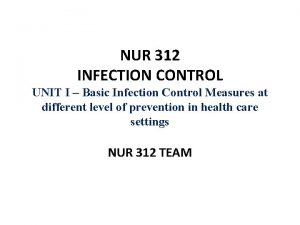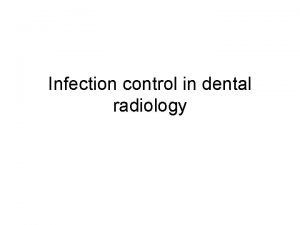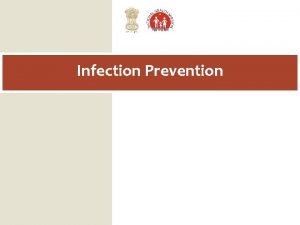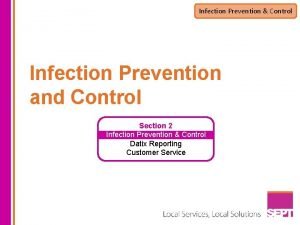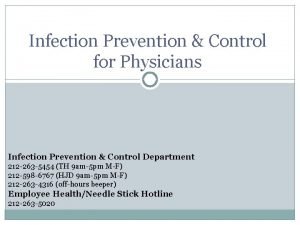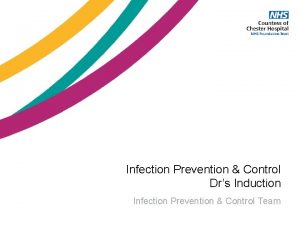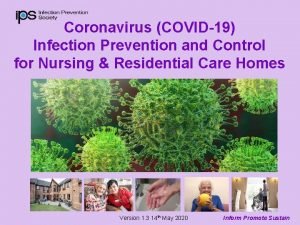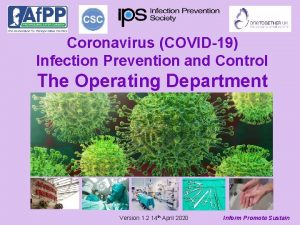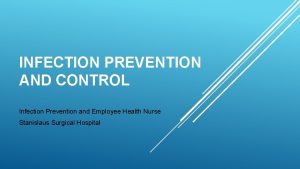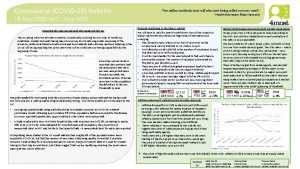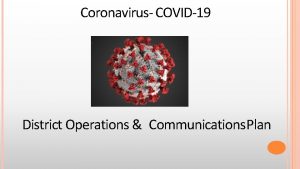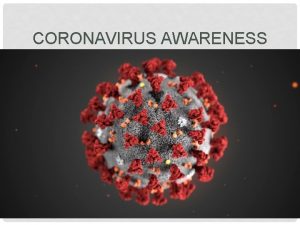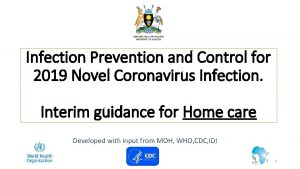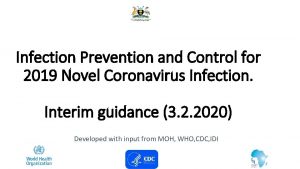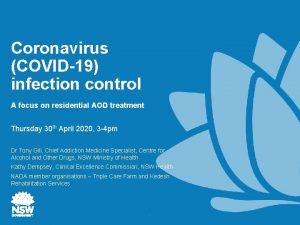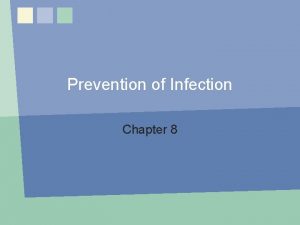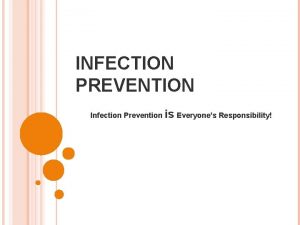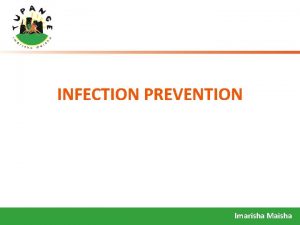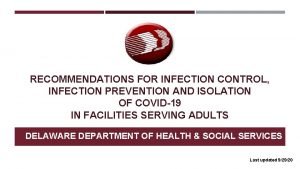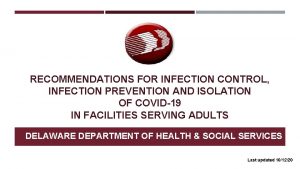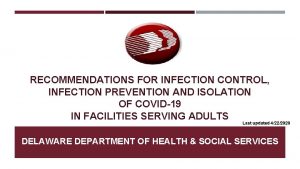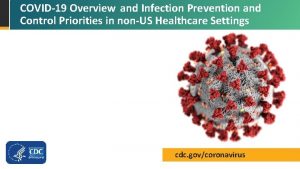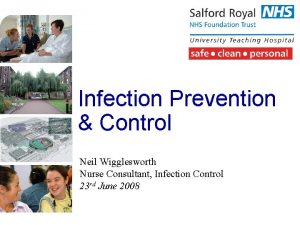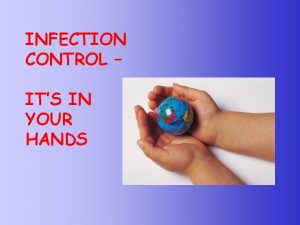Coronavirus COVID19 Infection Prevention and Control Inform Promote



























- Slides: 27

Coronavirus (COVID-19) Infection Prevention and Control Inform Promote Sustain

What is Coronavirus and COVID-19 § Coronaviruses are a large family of viruses - they cause infections ranging from the common cold to Severe Acute Respiratory Syndrome (SARS) § Coronaviruses circulate between animals and humans; sometimes new variants of the coronavirus emerge - such as COVID-19 § COVID-19 has the potential to spread widely as lack of immunity means everyone in the population is susceptible Inform Promote Sustain

What are the symptoms of COVID-19? § Symptoms start 5 -11 days after exposure § Similar to seasonal flu § Majority have fever and dry cough (rapid onset) § Symptoms last 5 - 6 days § Severe illness starts day 7 § Shortness of breath § Lung inflammation § Pneumonia Proportion of cases Symptom Fever >37. 8 o. C 88% Dry cough 68% Fatigue 38% Sputum 33% Shortness of breath 19% Muscle/joint pain 15% Sore throat 14% Headache 14% Inform Promote Sustain

Severity of COVID-19 illness § Most people have no obvious symptoms (30 -40%) § Most children get mild disease § More severe disease in: § § § Critical Respiratory/muliorgan failure Severe Shortness of breath; Respiration; O 2 sats Mild Older people Diabetics Heart disease Chronic respiratory disease Immune compromised § Less than 2% of cases fatal Fever, cough Undetected § Highest in high risk groups Inform Promote Sustain

How is COVID-19 transmitted? § Exposure to large respiratory droplets & vomit § Coughing/sneezing onto mucous membranes (mouth/eyes) § Need close contact for this to occur (within 1 metre) § Contact with respiratory secretions § Transferred by touching mucous membranes § Tissues/surfaces contaminated with respiratory secretions It is NOT transmitted in air except if patient undergoing a procedure that generates aerosols e. g. airway suction Inform Promote Sustain

Infection Prevention & Control Strategies 1. Cough etiquette 2. Standard precautions 3. Isolation precautions Better Medicine Better Health

Personal hygiene to prevent spread § Cough etiquette § Cover mouth and nose with a tissue or your sleeve (not your hands) § Dispose of tissues directly into bin § Hand hygiene Ensure patients § after contact coughing/sneezing have hand wipes or alcohol gel available Inform Promote Sustain

Standard Precautions § Essential to minimize risk of transmission between staff and patients § Will reduce the risk of transferring the virus from patients not recognized to have COVID-19 Ø Ø Hand hygiene Protective clothing for contact with body fluid Safe disposal of waste Clean equipment & environment Inform Promote Sustain

Hand Hygiene § Immediately before touching a patient § Before a clean/aseptic procedure § Immediately after touching patient or their surroundings § After removing gloves Alcohol gel is effective against COVID-19 Soap and water should be used if hand are soiled Inform Promote Sustain

Patient hand hygiene § Encourage patients to clean their hands § After coughing/sneezing § Before eating § After toilet § Make hand wipes or alcohol gel available at bedside for patients to use Inform Promote Sustain

Standard precautions: Gloves § For procedures involving DIRECT contact with blood or body fluid § Risk assess procedure § if gloves are indicated put on immediately before commencing procedure § Remove and decontaminate hands immediately after the procedure Take gloves off promptly! Virus (and other pathogens) are transferred between patients, surfaces and your own mucous membranes on your gloved hands Inform Promote Sustain

Standard Precautions: Aprons § For procedures where there is a risk that the clothing may become soiled § Risk assess procedure § if indicated put on immediately before commencing procedure § Remove if contaminated or on leaving the patient and decontaminate hands Inform Promote Sustain

Droplet Isolation Precautions for patients with COVID-19 § Infection is transmitted by respiratory droplets and contact with respiratory secretions therefore: § § Single room or cohort in bay with other infected patients Protective clothing for close contact (1 metre) Protective clothing for direct contact with body fluid Clean surfaces daily § Clean frequently touched surfaces more often § Use detergent followed by disinfectant § Dedicated patient equipment Remember to avoid touching your mouth, nose and eyes Inform Promote Sustain

Airborne isolation precautions in ICU/HDU where patients have COVID-19 § High incidence of patients undergoing aerosol generating procedures § All staff to wear : § FFP 3 masks +/- eye protection § Waterproof long-sleeved gowns § Gloves § must be changed + hands decontaminated between procedures § Surgical mask - if patient in negative pressure room Remember to avoid touching your mouth, nose and eyes Inform Promote Sustain

Isolation precautions in residential care For residents with known/suspected COVID-19 § Infection is transmitted by respiratory droplets and contact with respiratory secretions therefore: § § § Resident to remain in their room (including for meals) Must have en-suite facilities Protective clothing for close contact (1 metre) Protective clothing for direct contact with body fluid Clean surfaces daily § Clean frequently touched surfaces more often § Use detergent followed by disinfectant § Dedicated patient equipment Remember to avoid touching your mouth, nose and eyes Inform Promote Sustain

Protective clothing Known or suspected COVID-19 § Surgical mask - when in close contact (1 metre) § Eye protection - if risk of splashing § Gloves - for close contact, respiratory secretions, body fluids § MUST be changed between procedures to protect patient from infection § Apron - for close contact § change if soiled § fluid-resistant disposable gown only for aerosol generating procedures Remember to avoid touching your mouth, nose and eyes Inform Promote Sustain

Removal of protective clothing § Discard mask when moist or damaged § Remove PPE in this order: 1. Gloves 2. Apron (avoid touching contaminated front surface) 3. Mask/eye protection (if worn) § Decontaminate hands after PPE has been removed Inform Promote Sustain

Remember! Don’t touch your mouth, nose or eyes. Decontaminate your hands thoroughly on leaving the area/room. Inform Promote Sustain

FFP 3 Masks § Filters out very small particles § Protects from inhalation of fine airborne particles § Filtration effective only if sealed to contour of face (fit testing required) § Required for procedures which generate aerosols of respiratory secretions (AGP) § with long-sleeved gowns & gloves § Not necessary for other close contact Aerosol Generating Procedures Intubation & extubation Tracheostomy Airway suction Manual ventilation Non-invasive ventilation (Bi. PAP, CPAP) & high-frequency oscillating ventilation (HFOV) High flow nasal oxygen Chest physiotherapy Sputum induction Bronchoscopy Surgery - high speed devices Inform Promote Sustain

Why the change in infection control precautions? § New virus therefore at beginning of the outbreak little was known about route of transmission & mortality § COVID-19 has now been declassified as High Consequence Infectious Disease (HCID) § Established that is spread by respiratory droplets not airborne § Precautions the same as for influenza: § Surgical masks protect mucous membrane from contamination by large respiratory droplet (and are as effective as FFP 3 for this) § FFP 3 recommended for Aerosol Generating Procedures (AGP) and supply needs to be protected for this purpose Inform Promote Sustain

Summary of precautions for patients with COVID-19 Personal Protective Equipment Close patient contact (within 2 m) Enter room but no contact with patient or environment Cleaning room/area (Domestic staff) AGP Apron Surgical mask Long sleeved disposable gown FFP 3 respirator Eye protection Risk assess Gloves AGP = aerosol generating procedures Inform Promote Sustain

Cohorting Placing patients with COVID-19 in bay/area Key Principles § Patients must have tested positive and not have other infections § Patients with suspected but not confirmed COVID-9 should be in a separate area § Use privacy curtains to minimise droplet exposure § Staff should be assigned to work in COVID designated areas and not care for other patients § Must change gloves/aprons between patients § Must decontaminate hands between patients Remember to avoid touching your mouth, nose and eyes Inform Promote Sustain

Environmental contamination § Surfaces may become contaminated with respiratory secretions § Directly from coughing/sneezing § Indirectly by touching with contaminated hands § Contamination greatest where AGP performed § COVID-19 unlikely to survive in significant numbers on surfaces for longer than 3 days § Can recover virus particles but not evidence on whether they are viable and able to cause infection § Easily removed by cleaning § Detergent & water followed by disinfectant § Chlorine at 1000 ppm effective Inform Promote Sustain

Disposal of waste & laundry § § Waste - discard as clinical waste Laundry - as infected laundry Body fluid spoils - as usual local policy Uniforms § change before leaving work § If washing at home wash separately and do not overfill machine Inform Promote Sustain

Staff with COVID-19 § If you develop symptoms of a flu-like illness then DO NOT come into work: § Acute onset fever >37. 8 o. C and new persistent cough § Inform your manager § Self-isolate at home for 7 days from onset of symptoms § If your symptoms worsen contact NHS 111 § Staff at high risk of complications from COVID-19 § risk-assessment to manage their deployment Inform Promote Sustain

Strategy for testing and managing patients with suspected COVID-19 Inform Promote Sustain

Useful resources Public Health England Campaign Resources https: //campaignresources. phe. gov. uk/resources/campaigns/101 -coronavirus- Public Health England Coronavirus (COVID-19) guidance https: //www. gov. uk/government/collections/coronavirus-covid-19 -list-of-guidance https: //assets. publishing. service. gov. uk/government/uploads/system/uploads/attach ment_data/file/872745/Infection_prevention_and_control_guidance_for_pandemic_ coronavirus. pdf NHS England https: //www. england. nhs. uk/ourwork/eprr/coronavirus/ NHS website https: //www. nhs. uk/conditions/coronavirus-covid-19/ Healthcare Infection Society https: //his. org. uk/resources-guidelines/novel-coronavirus-resources/ World Health Organization https: //www. who. int/emergencies/diseases/novel-coronavirus-2019 Inform Promote Sustain
 Primary prevention secondary prevention tertiary prevention
Primary prevention secondary prevention tertiary prevention Chapter 16 infection prevention and control
Chapter 16 infection prevention and control Chapter 19 disease transmission and infection prevention
Chapter 19 disease transmission and infection prevention Chapter 19 disease transmission and infection prevention
Chapter 19 disease transmission and infection prevention Chapter 19 disease transmission and infection prevention
Chapter 19 disease transmission and infection prevention Define infection prevention chapter 5
Define infection prevention chapter 5 Scissurite coronavirus
Scissurite coronavirus Relazione finale funzione strumentale orientamento
Relazione finale funzione strumentale orientamento Mehmet dorak
Mehmet dorak 2 factores abioticos
2 factores abioticos Rischio biologico coronavirus | titolo x d.lgs. 81/08
Rischio biologico coronavirus | titolo x d.lgs. 81/08 Contatto indiretto
Contatto indiretto Bronquite coronavirus
Bronquite coronavirus Http//apps.tujuhbukit.com/covid19
Http//apps.tujuhbukit.com/covid19 Do if you covid19
Do if you covid19 Covid19 athome rapid what know
Covid19 athome rapid what know What do if test positive covid19
What do if test positive covid19 Vaksin covid19
Vaksin covid19 Chapter 16 infection control and standard precautions
Chapter 16 infection control and standard precautions Exposure incident milady
Exposure incident milady Certification board of infection control and epidemiology
Certification board of infection control and epidemiology Labial mounting
Labial mounting Chapter 15:8 using sterile techniques
Chapter 15:8 using sterile techniques Chapter 15:8 using sterile techniques
Chapter 15:8 using sterile techniques Cic certification infection control
Cic certification infection control Infection control definition
Infection control definition Infection control in dental radiology
Infection control in dental radiology Learning objectives for infection control
Learning objectives for infection control





